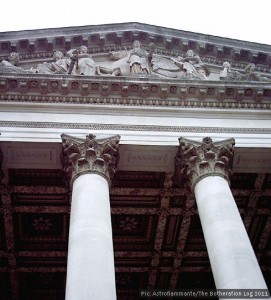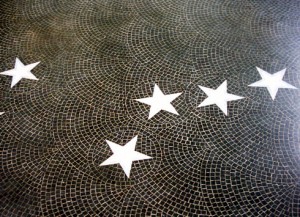Fitzwilliam Museum: Meeting the ancestors
It’s a lovely thing about visiting Cambridge – the place is heaving with free museums. And queen among them must surely be The Fitzwilliam.

The Fitzwilliam: A frontage to remember
I only visited for the first time recently, but now I pop in whenever I get a chance, not least to look at any new exhibitions they have on. But also to wander around the classical or Egyptian galleries and feel gently inspired, or to come face to face with works by Picasso, Constable, Titian or Monet (to name-drop just a few). On my last visit, I counted no less than three Barbara Hepworth sculptures. Three! You’d have trouble seeing more than that in one place without going all the way down to St Ives itself. (The Cornish one, that is, not the local alternative.)
It is, of course, a monument to one man’s collecting passion, as these places so often are. But its collections are extraordinarily rich, and it also offers a handy display space for anything the Colleges want to show off – no wonder it’s a bit like finding the National Gallery perched on top of the British Museum, scaled down to a comfortable size for a city like Cambridge. This, of course, is hardly your usual provincial town or East Anglian burgh, but even so this place has a metropolitan feel about it.
When I was a child, I used to clamour at weekends to be taken to the London museums – the Science Museum, the Natural History Museum, what was then the Geological Museum, now the Earth Galleries of the aforementioned. And the British Museum, lots. Like many kids aged between about seven and 12, I was obsessed with things like dinosaurs, volcanoes, space travel and ancient Egypt, which explains it all, really. Conversely, I took a little longer to catch up with the fine and applied arts, and so never really developed the same intimate relationship with the V&A that I did with the others.
Over the course of a few years I went back to South Kensington time and time again to see my favourite things, not least the Egyptian mummies, some of which frightened the living daylights out of me. Now, sensibilities regarding human remains have changed a fair bit since then, and there are possibly fewer human bodies in museum cases than once there were. If this is a topic you find interesting, check out the Museum of London’s and the British Museum’s policies on this subject plus some visitor research via the links. Oxford’s Pitt Rivers Museum and the Science Museum also have publicly-accessible policies. The Fitzwilliam has a magnificent Egyptian collection, including a number of coffins and grave goods and a single mummy, that left me feeling as delighted as a child to be viewing objects of such beauty and antiquity.
At the Fitzwilliam it’s a big culture shock when you wander out of the classical world and find yourself in a huge room full of decorative china. And don’t for goodness sake spend too long on the ground floor if you also intend to have a really good browse around the art upstairs. The museum is full of unexpected treasures – personally, I feel a lot of effort would be needed to beat either the fan gallery or the tiny but beautiful Mediaeval and Renaissance gallery nearby – its size perfectly pitched to the scale of the objects it displays. So, the upshot of all this from someone (me) who is a really dedicated museum visitor is this: it would be a crying shame to live or travel within range of the Fitzwilliam and not visit, so I suggest you do.

The Polar Museum's famous painted ceiling, with the North Pole shown
On the same day I also called in at the nearby Polar Museum – the public face of the Scott Polar Research Institute, part of the University of Cambridge. This is small in floor space terms but huge in the range and importance of the artefacts it has. As well as describing the circumstances of some of the indigenous peoples living close to the North Pole it catalogues the various attempts to get ‘furthest North’ as well as covering Scott’s and Roald Amundsen’s trips into Antarctica in some detail, and explaining the importance of the polar regions to scientists today. Among the most affecting of its artefacts are the letters home from Scott’s doomed expedition, some from people who knew they would not return, cleverly displayed using a drawer system.

A floor mosaic of the Pole Star constellation
On the day I visited the place was humming with visitors, many of them members of a Japanese group evidently touring Cambridge with their local guides. A good third of the exhibition space was also being remodelled for a major new show on Amundsen, so the place was pretty tightly-packed. I don’t know whether that is usual or not, but I do think that a visit is something that you should allow at least an hour or two for, especially if you find these far-flung regions of the earth fascinating or the story of the Scott expedition especially moving.
The Fitzwilliam – and some other great Cambridge museums
- The Fitzwilliam Museum (Free admission – donation suggested)
- The Polar Museum (Free admission – donation suggested)
- Cambridge University Botanic Gardens (Adults £4, kids and University students free)
- Museum of Archaeology and Anthropology (Free admission)
- The Museum of Classical Archaeology (Free admission)
- Kettle’s Yard (Free admission)
- Sedgwick Museum of Earth Sciences (Free admission)
- Whipple Museum of the History of Science (Free admission – donation suggested)
Admission prices valid at the time this post was written – check with each institution individually if you plan to visit.